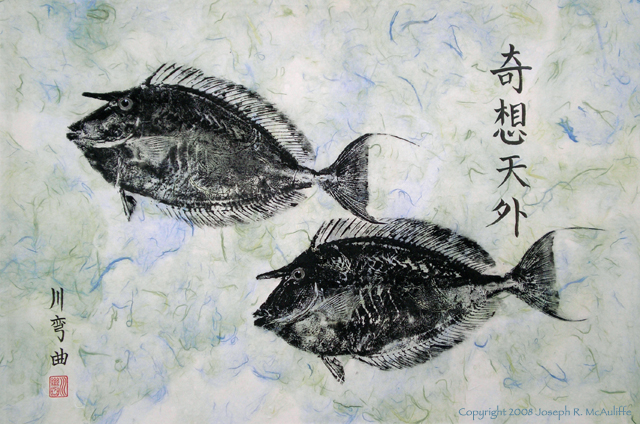
These are bluespined unicornfish (Naso unicornis), inhabitants of tropical reefs in the Red Sea, Indian Ocean, and western Pacific Ocean, including Hawaii. There are over 20 species of unicornfish and most have an unusual horn projecting from their heads. The horns are absent in young fish and develop with increasing age and size. Bluespined unicornfish grow to slightly over two feet long and they start to develop horns when about 5 inches long. Recent research on this and one other unicornfish species suggests that the horn plays an important part in courtship and spawning. Adult males tend to have larger horns than do females. Males can rapidly change the color of their horns and may use these changes to signal receptive females. Contests among males also involve display and quick color changes of the horn by dominant males toward smaller, subordinate males.
In addition to the horn, unicornfish possess another unusual characteristic. They are members of the surgeonfish family (Acanthuridae), so named because they possess sharp, scalpel-like processes that project laterally from the place where the body narrows just in front of the tail (the caudal peduncle). The bluespined unicornfish have two of these blades on each side; each blade is surrounded by a small circular area of bright blue. The bright blue contrasts sharply with the drab olive color of their bodies and may advertise the presence of the defensive weapons. These blades can deliver a painful laceration if a fish is carelessly handled. The bluespined surgeonfish has a tough, leathery skin that feels like smooth velvet when stroked from head to tail. However, trying to stroke the fish’s skin from tail to head is impossible.
I examined a piece of skin under a microscope and the skin is actually blanketed with small scales, each less that a half-millimeter across and covered with over a dozen short, needle-like spines, all facing towards the tail of the fish. The spines are less than a quarter-millimeter in length and are invisible to the naked eye, but long and sharp enough to catch hold of anything moving in the “wrong” direction. I wondered about the possible function of those scales. Perhaps, like the “surgeon” blades, the scales collectively provide a defense against being easy prey for larger predators. It is hard to imagine such a fish, seized tail-first, sliding easily down any other fish’s throat! Despite their formidable defensive armory, the unicornfishes tend to be quite docile and actually make good aquarium fish. In the wild, they feel primarily on coarse, leafy brown algae.
The calligraphic inscription reads (in Japanese) “kiso-tengai,” which means “an unusual idea from the sky.” This expression is used to describe something completely unexpected, surreal, or out of the ordinary.
Size: 36 x 24 inches (2006)
Return to Gallery 4.